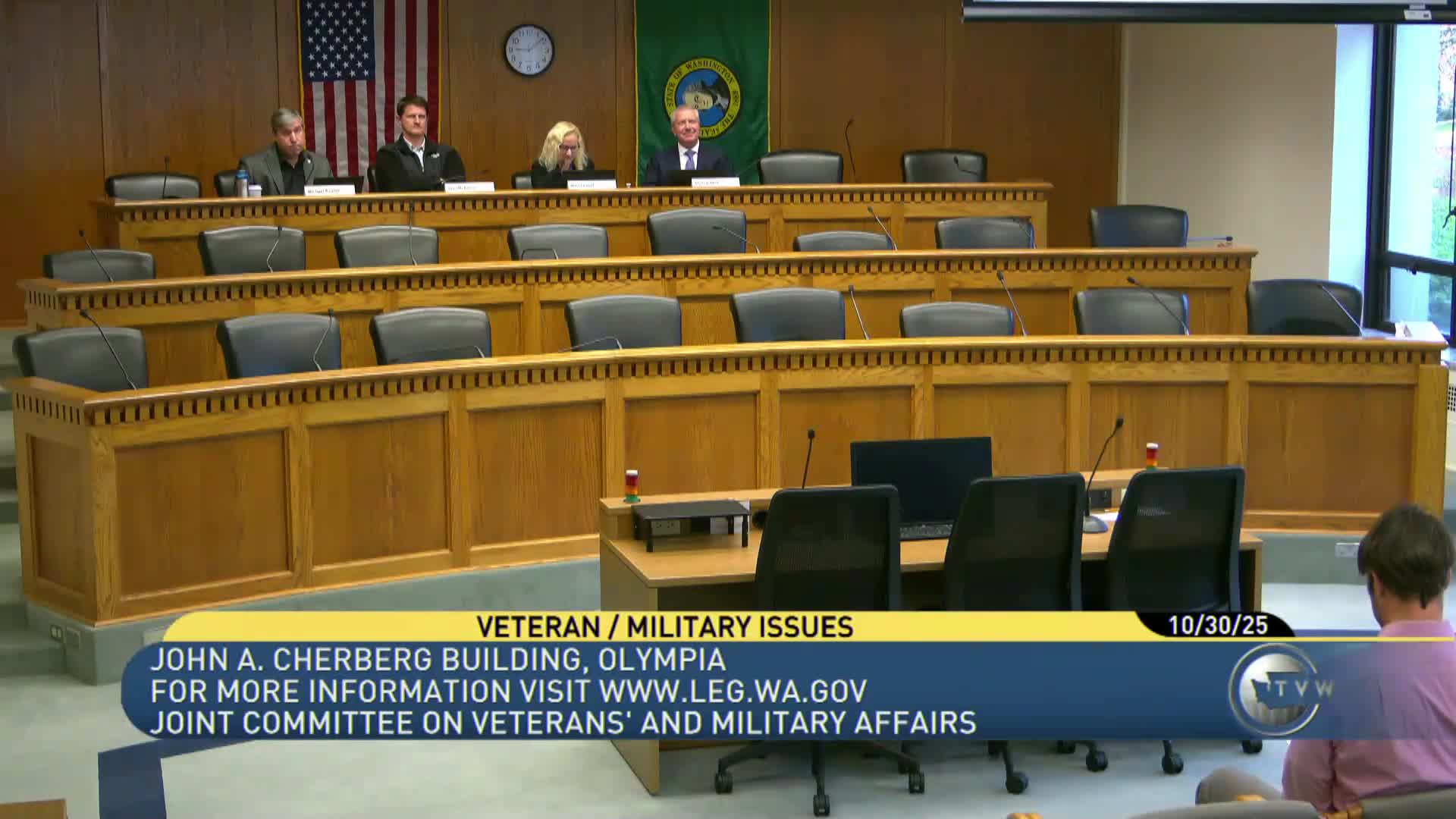Sentinel Landscape coordinator urges state support to limit encroachment around JBLM
October 30, 2025 | Legislative Sessions, Washington
This article was created by AI summarizing key points discussed. AI makes mistakes, so for full details and context, please refer to the video of the full meeting. Please report any errors so we can fix them. Report an error »

Dan Calvert, program coordinator for the Joint Base Lewis‑McChord Sentinel Landscape Partnership Program, told the Joint Committee on Military and Veterans Affairs that the partnership relies on voluntary, non‑regulatory cooperation with landowners to address encroachment around the installation.
"We rely on voluntary non regulatory cooperation and support from private landowners," Calvert said, explaining that encroachment includes regulatory restrictions tied to endangered species and development that limit where and when the base can train. He said JBLM contains "90% of the remaining prairie habitat in Western Washington," making habitat protection central to preserving training flexibility.
Calvert outlined the role of the Department of Defense's Readiness and Environmental Protection Integration (REPI) program, noting it is authorized in the National Defense Authorization Act and is one of the few federal sources that can fund off‑base land protection, management endowments and organizational capacity. He said REPI and related federal grants have provided nearly $14 million in local investments over the last four years for projects including a seed‑production coordinator, a shared restoration crew, captive rearing of endangered species and landowner outreach.
Calvert described a recent Pacific Lutheran University conservation easement: funding secured to protect 10 acres of prairie on PLU's campus, with about $3,000,000 to fund the conservation easement but not cover ongoing management costs such as prescribed burning. He said landowners and land trusts have identified additional willing participants but cited high land values, small parcel sizes and administrative complexity as barriers to quicker progress.
Calvert also reviewed unsuccessful federal proposals the partnership has submitted—an NRCS Regional Conservation Partnership Program (RCPP) proposal for a 100‑acre farm abutting JBLM and a larger 484‑acre conservation proposal—and described them as "ripe and ready" for funding if matching resources and administrative capacity can be found.
On state policy, Calvert suggested several approaches the committee could consider in follow‑up: codifying a state Sentinel Landscape designation to formalize agency coordination (examples exist in North Carolina and Utah), creating a dedicated state matching fund or appropriation to support conservation easements and management endowments, enabling additional entities to hold management endowments, allowing limited flexibility for prescribed fire during localized conditions, and exploring more flexible water‑right transfers to support conservation activities.
Calvert answered committee questions about seed sourcing—saying most seed is now produced by local nurseries with some wild collection, and that the partnership seeks to expand local growers—and about whether REPI funds can be used for acquisition near flight paths; he said REPI can be used for some acquisition work but local cost pressures mean federal dollars do not go as far as in other regions.
The presentation concluded with members asking Calvert to follow up on reports of reduced REPI staffing and national REPI funding; Calvert offered to provide additional information to the committee later.
"We rely on voluntary non regulatory cooperation and support from private landowners," Calvert said, explaining that encroachment includes regulatory restrictions tied to endangered species and development that limit where and when the base can train. He said JBLM contains "90% of the remaining prairie habitat in Western Washington," making habitat protection central to preserving training flexibility.
Calvert outlined the role of the Department of Defense's Readiness and Environmental Protection Integration (REPI) program, noting it is authorized in the National Defense Authorization Act and is one of the few federal sources that can fund off‑base land protection, management endowments and organizational capacity. He said REPI and related federal grants have provided nearly $14 million in local investments over the last four years for projects including a seed‑production coordinator, a shared restoration crew, captive rearing of endangered species and landowner outreach.
Calvert described a recent Pacific Lutheran University conservation easement: funding secured to protect 10 acres of prairie on PLU's campus, with about $3,000,000 to fund the conservation easement but not cover ongoing management costs such as prescribed burning. He said landowners and land trusts have identified additional willing participants but cited high land values, small parcel sizes and administrative complexity as barriers to quicker progress.
Calvert also reviewed unsuccessful federal proposals the partnership has submitted—an NRCS Regional Conservation Partnership Program (RCPP) proposal for a 100‑acre farm abutting JBLM and a larger 484‑acre conservation proposal—and described them as "ripe and ready" for funding if matching resources and administrative capacity can be found.
On state policy, Calvert suggested several approaches the committee could consider in follow‑up: codifying a state Sentinel Landscape designation to formalize agency coordination (examples exist in North Carolina and Utah), creating a dedicated state matching fund or appropriation to support conservation easements and management endowments, enabling additional entities to hold management endowments, allowing limited flexibility for prescribed fire during localized conditions, and exploring more flexible water‑right transfers to support conservation activities.
Calvert answered committee questions about seed sourcing—saying most seed is now produced by local nurseries with some wild collection, and that the partnership seeks to expand local growers—and about whether REPI funds can be used for acquisition near flight paths; he said REPI can be used for some acquisition work but local cost pressures mean federal dollars do not go as far as in other regions.
The presentation concluded with members asking Calvert to follow up on reports of reduced REPI staffing and national REPI funding; Calvert offered to provide additional information to the committee later.
View full meeting
This article is based on a recent meeting—watch the full video and explore the complete transcript for deeper insights into the discussion.
View full meeting
